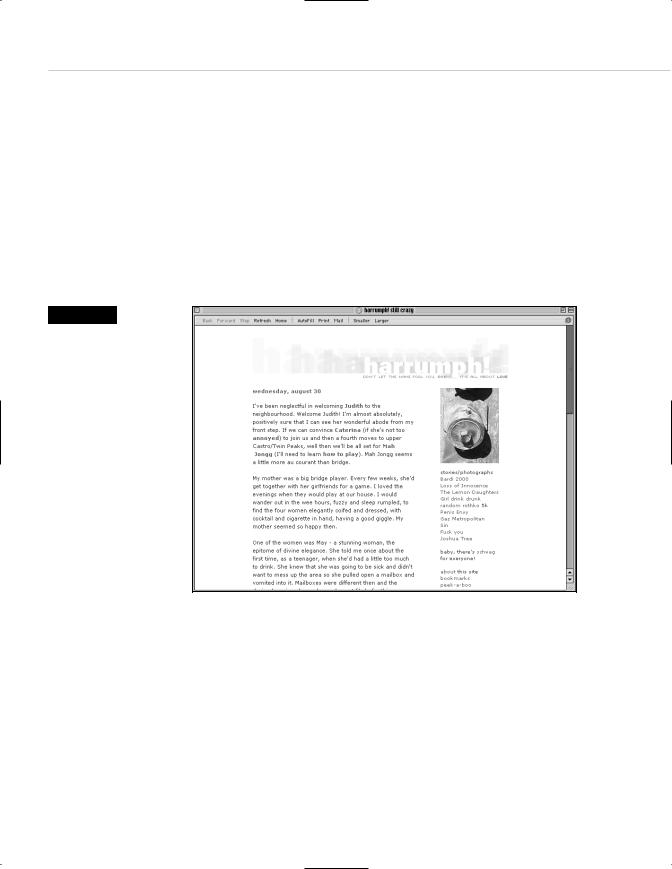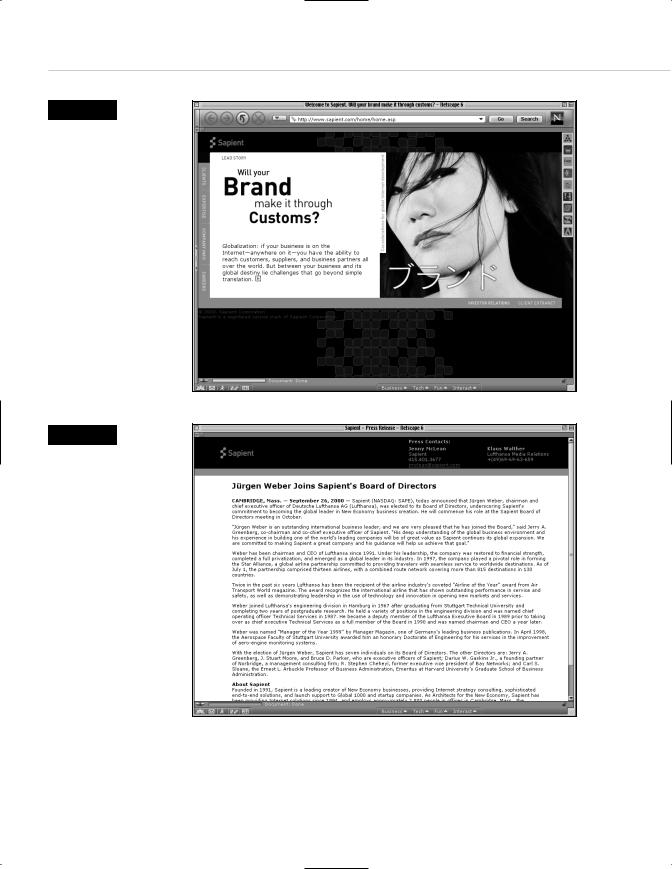
- •Taking Your Talent to the Web
- •Introduction
- •1 Splash Screen
- •Meet the Medium
- •Expanding Horizons
- •Working the Net…Without a Net
- •Smash Your Altars
- •Breath Mint? Or Candy Mint?
- •Where’s the Map?
- •Mars and Venus
- •Web Physics: Action and Interaction
- •Different Purposes, Different Methodologies
- •Web Agnosticism
- •Point #1: The Web Is Platform-Agnostic
- •Point #2: The Web Is Device-Independent
- •The 18-Month Pregnancy
- •Chocolatey Web Goodness
- •’Tis a Gift to Be Simple
- •Democracy, What a Concept
- •Instant Karma
- •The Whole World in Your Hands
- •Just Do It: The Web as Human Activity
- •The Viewer Rules
- •Multimedia: All Talking! All Dancing!
- •The Server Knows
- •It’s the Bandwidth, Stupid
- •Web Pages Have No Secrets
- •The Web Is for Everyone!
- •Swap text and code for images
- •Prune redundancy
- •Cache as Cache Can
- •Much Ado About 5K
- •Screening Room
- •Liquid Design
- •Color My Web
- •Thousands Weep
- •Gamma Gamma Hey!
- •Typography
- •The 97% Solution
- •Points of Distinction
- •Year 2000—Browsers to the Rescue
- •Touch Factor
- •Appropriate Graphic Design
- •User Knowledge
- •What Color Is Your Concept?
- •Business as (Cruel and) Usual
- •The Rise of the Interface Department
- •Form and Function
- •Copycats and Pseudo-Scientists
- •Chaos and Clarity
- •A Design Koan: Interfaces Are a Means too Often Mistaken for an End
- •Universal Body Copy and Other Fictions
- •Interface as Architecture
- •Ten (Okay, Three) Points of Light
- •Be Easily Learned
- •Remain Consistent
- •Continually Provide Feedback
- •GUI, GUI, Chewy, Chewy
- •It’s the Browser, Stupid
- •Clarity Begins at Home (Page)
- •I Think Icon, I Think Icon
- •Structural Labels: Folding the Director’s Chair
- •The Soul of Brevity
- •Hypertext or Hapless Text
- •Scrolling and Clicking Along
- •Stock Options (Providing Alternatives)
- •The So-Called Rule of Five
- •Highlights and Breadcrumbs
- •Consistent Placement
- •Brand That Sucker!
- •Why We Mentioned These Things
- •The year web standards broke, 1
- •The year web standards broke, 2
- •The year web standards broke, 3
- •The year the bubble burst
- •5 The Obligatory Glossary
- •Web Lingo
- •Extranet
- •HTML
- •Hypertext, hyperlinks, and links
- •Internet
- •Intranet
- •JavaScript, ECMAScript, CSS, XML, XHTML, DOM
- •Web page
- •Website
- •Additional terminology
- •Web developer/programmer
- •Project manager
- •Systems administrator (sysadmin) and network administrator (netadmin)
- •Web technician
- •Your Role in the Web
- •Look and feel
- •Business-to-business
- •Business-to-consumer
- •Solve Communication Problems
- •Brand identity
- •Restrictions of the Medium
- •Technology
- •Works with team members
- •Visually and emotionally engaging
- •Easy to navigate
- •Compatible with visitors’ needs
- •Accessible to a wide variety of web browsers and other devices
- •Can You Handle It?
- •What Is the Life Cycle?
- •Why Have a Method?
- •We Never Forget a Phase
- •Analysis (or “Talking to the Client”)
- •The early phase
- •Design
- •Brainstorm and problem solve
- •Translate needs into solutions
- •Sell ideas to the client
- •Identify color comps
- •Create color comps/proof of concept
- •Present color comps and proof of concept
- •Receive design approval
- •Development
- •Create all color comps
- •Communicate functionality
- •Work with templates
- •Design for easy maintenance
- •Testing
- •Deployment
- •The updating game
- •Create and provide documentation and style guides
- •Provide client training
- •Learn about your client’s methods
- •Work the Process
- •Code Wars
- •Table Talk
- •XHTML Marks the Spot
- •Minding Your <p>’s and q’s
- •Looking Ahead
- •Getting Started
- •View Source
- •A Netscape Bonus
- •The Mother of All View Source Tricks
- •Doin’ it in Netscape
- •Doin’ it in Internet Explorer
- •Absolutely Speaking, It’s All Relative
- •What Is Good Markup?
- •What Is Sensible Markup?
- •HTML as a Design Tool
- •The Frames of Hazard
- •Please Frame Safely
- •Framing Your Art
- •<META> <META> Hiney Ho!
- •Search Me
- •Take a (Re)Load Off
- •WYSIWYG, My Aunt Moira’s Left Foot
- •Code of Dishonor
- •WYS Is Not Necessarily WYG
- •Publish That Sucker!
- •HTMHell
- •9 Visual Tools
- •Photoshop Basics: An Overview
- •Comp Preparation
- •Dealing with Color Palettes
- •Exporting to Web-Friendly Formats
- •Gamma Compensation
- •Preparing Typography
- •Slicing and Dicing
- •Rollovers (Image Swapping)
- •GIF Animation
- •Create Seamless Background Patterns (Tiles)
- •Color My Web: Romancing the Cube
- •Dither Me This
- •Death of the Web-Safe Color Palette?
- •A Hex on Both Your Houses
- •Was Blind, but Now I See
- •From Theory to Practice
- •Format This: GIFs, JPEGs, and Such
- •Loves logos, typography, and long walks in the woods
- •GIFs in Photoshop
- •JPEG, the Other White Meat
- •Optimizing GIFs and JPEGs
- •Expanding on Compression
- •Make your JPEGS smaller
- •Combining sharp and blurry
- •Animated GIFs
- •Creating Animations in ImageReady
- •Typography
- •The ABCs of Web Type
- •Anti-Aliasing
- •Specifying Anti-Aliasing for Type
- •General tips
- •General Hints on Type
- •The Sans of Time
- •Space Patrol
- •Lest We Fail to Repeat Ourselves
- •Accessibility, Thy Name Is Text
- •Slicing and Dicing
- •Thinking Semantically
- •Tag Soup and Crackers
- •CSS to the Rescue…Sort of
- •Separation of Style from Content
- •CSS Advantages: Short Term
- •CSS Advantages: Long Term
- •Compatibility Problems: An Overview
- •Working with Style Sheets
- •Types of Style Sheets
- •External style sheets
- •Embedding a style sheet
- •Adding styles inline
- •Fear of Style Sheets: CSS and Layout
- •Fear of Style Sheets: CSS and Typography
- •Promise and performance
- •Font Size Challenges
- •Points of contention
- •Point of no return: browsers of the year 2000
- •Absolute size keywords
- •Relative keywords
- •Length units
- •Percentage units
- •Looking Forward
- •11 The Joy of JavaScript
- •What Is This Thing Called JavaScript?
- •The Web Before JavaScript
- •JavaScript, Yesterday and Today
- •Sounds Great, but I’m an Artist. Do I Really Have to Learn This Stuff?
- •Educating Rita About JavaScript
- •Don’t Panic!
- •JavaScript Basics for Web Designers
- •The Dreaded Text Rollover
- •The Event Handler Horizon
- •Status Quo
- •A Cautionary Note
- •Kids, Try This at Home
- •The Not-So-Fine Print
- •The Ever-Popular Image Rollover
- •A Rollover Script from Project Cool
- •Windows on the World
- •Get Your <HEAD> Together
- •Avoiding the Heartbreak of Linkitis
- •Browser Compensation
- •JavaScript to the Rescue!
- •Location, location, location
- •Watching the Detection
- •Going Global with JavaScript
- •Learning More
- •12 Beyond Text/Pictures
- •You Can Never Be Too Rich Media
- •Server-Side Stuff
- •Where were you in ‘82?
- •Indiana Jones and the template of doom
- •Serving the project
- •Doing More
- •Mini-Case Study: Waferbaby.com
- •Any Size Kid Can Play
- •Take a Walk on the Server Side
- •Are You Being Served?
- •Advantages of SSI
- •Disadvantages of SSI
- •Cookin’ with Java
- •Ghost in the Virtual Machine
- •Java Woes
- •Java Woes: The Politically Correct Version
- •Java Joys
- •Rich Media: Exploding the “Page”
- •Virtual Reality Modeling Language (VRML)
- •SVG and SMIL
- •SMIL (through your fear and sorrow)
- •Romancing the logo
- •Sounds dandy, but will it work?
- •Promises, Promises
- •Turn on, Tune in, Plug-in
- •A Hideous Breach of Reality
- •The ubiquity of plug-ins
- •The Impossible Lightness of Plug-ins
- •Plug-ins Most Likely to Succeed
- •Making It Work: Providing Options
- •The “Automagic Redirect”
- •The iron-plated sound console from Hell
- •The Trouble with Plug-ins
- •If Plug-ins Run Free
- •Parting Sermon
- •13 Never Can Say Goodbye
- •Separation Anxiety
- •A List Apart
- •Astounding Websites
- •The Babble List
- •Dreamless
- •Evolt
- •Redcricket
- •Webdesign-l
- •When All Else Fails
- •Design, Programming, Content
- •The Big Kahunas
- •Beauty and Inspiration
- •Index

Taking Your Talent to the Web |
91 |
Because most web users have little time and less bandwidth to waste, good interfaces are rarely overwrought. Given the choice between a simple, functional design and one that is ornate, most folks prefer the simple web layout that loads quickly and is easy to understand. Web users don’t tell you this by peering over your shoulder; they tell you this by visiting the site or neglecting it.
Even when bandwidth is not an issue, quick, clear communication always will be. Users lucky enough to have T3, cable modem, or DSL access may not be slowed down by a cluttered interface, but they will be just as baf-
fled by it as dialup modem users are. Regardless of the user’s access speed, your communication must be fast and clear, or users will retreat faster than you can say “failed dot com.” It’s a peanut butter and jelly scenario: By focusing on functionality, you will develop low bandwidth interfaces; by focusing on bandwidth, you will develop interfaces that speak quickly and clearly.
Many web designers initially feel constrained by this. Some feel they cannot truly express their vision unless every page sports a 128K background JPEG, an animated menu bar, and a series of spinning logos and pulsing photographs. We’ve all had that feeling. It passes as you discover the joy of communicating richly while using a few elements well, or it never passes, and you locate clients with tastes as baroque as yours. When citizens avoid visiting the resulting sites, your client and you can toast your superiority to the rest of humanity and then hurry on to the next failure.
When bad web designers die and go to Hell, they will spend eternity searching for the Heaven option on an endless menu bar of purgatories. (That is, if they’re not simply stuck waiting for an infernal intro to finish downloading.)
Hypertext or Hapless Text
Brevity is just as important when putting text content on the Web. A book is easy to read. Hundreds of years of book design make it so. But on a glaring computer screen, at 72ppi (pixels per inch) or 96ppi, reading long passages is a chore. A reader will simply skip lengthy texts, whether they’re providing valuable product information or explaining how to use some advanced feature of the site.

92 WHY: Where Am I? Navigation & Interface: Clarity Begins at Home (Page)
By breaking text down into usable sub-units of information, a web designer can help readers find critical information and more easily absorb content. White space, while useful in print, becomes even more crucial on a web page. The logical separation of chunks of information helps engage readers and maintain their interest. Designers can use paragraphs, section breaks, and links to new pages to chunk information.
The more white space, the greater the chance that readers will remain engaged. Use CSS by itself or in combination with table-based layouts to create pages that demand to be read.
Figure 3.13
Readable typography, an elegantly spare layout, and plenty of white space add up to a site that welcomes readers—a quality that is depressingly rare on the Web (www.harrumph.com). Contrast this with
Figure 3.15.
In print, a designer might include ten sentences in a paragraph. On the Web, with its scrolling interface, ten sentences can feel like a life sentence. To enhance readability, web designers (or web designers in combination with web-savvy copywriters and editors) will separate one long paragraph into several shorter ones.
Learn when to stop one page and start another. Despite what some pundits tell you, readers will scroll to read an engaging story, but they will not scroll forever. After two or three screens, it may be time to present the

Taking Your Talent to the Web |
93 |
reader with an arrow (or other page indicator) allowing them to move on to the next page of text. Doing so can relieve eye fatigue, enhance the drama of the presentation (www.fray.com), or simply give your client another page on which to sell ad banners.
Remember in Chapter 2 when we talked about the tradeoff between one large image that takes a long time to download and many small images that take a long time to display? (If this were a web page, we’d provide a link here.) Well, the same kind of tradeoff goes on with text. Jam too much of it on a single web page, and readers may be frightened away. Provide too little, forcing the reader to click to a new screen after every paragraph or two, and you practically guarantee that no one will read to the end of the article or story.
Working with client-supplied text is particularly tricky. If average citizens are bad writers, clients are bad writers with egos. Upper Middle Managers would rather add value to cross-brand synergies while enhancing the functionality of strategically targeted product from the dairy side than put milk in their coffee. Rare is the client who writes the way people talk; rarer still is the client who uses few words when many will suffice.
In brochures and catalogs, such copy is ineffective. On a web page, it’s destructive on a nuclear scale. Consumers may ignore bad catalog copy if the layout and photography are compelling enough. But a site laden with vast blocks of ham-handed text is doomed. No visitor will stay long enough or scroll far enough to discover the million dollar photographs or compelling brand proposition buried on page three.
Laid out well (via text chunking and CSS), bad text can squeak by. Laid out badly, it kills websites dead. We cannot overemphasize the impact (and tragic rarity) of good writing on the Web nor the harm done by verbose and inexpressive texts, drizzled into layouts like so much phlegm. Learn web typography, practice text chunking, and work with good writers and editors. Do not let your clients or your project managers skimp on the writing budget unless you find failure exciting.

94 WHY: Where Am I? Navigation & Interface: Clarity Begins at Home (Page)
Figure 3.14
The front page of Sapient.com
(www.sapient.com),
a leading web agency, shows mastery and promise. Clean typography and highquality photography, balanced as skillfully as in a classic Ogilvie print ad, direct the visitor’s attention to the most important content. The carefully balanced page also makes use of Liquid Design (see Chapter 2) to accommodate variously sized monitors.
So far, so good.…
Figure 3.15
…Alas, once past the front page, visitors encounter too many pages like this one, where blocks of undifferentiated text, laid out with little care and no love, beg to be ignored rather than read. Since 99% of the Web consists of text that is intended to be read, the lack of attention to good textual presentation is tragic—hurting not only the site owner, but the would-be reader. Contrast this with Figure 3.13. (www.sapient.com).
